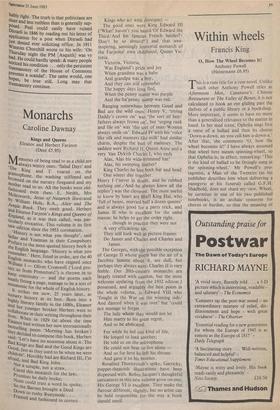Monarchs
Caroline Dawnay
Kings and Queens Eleanor and Herbert Farjeon (Dent £5.95)
Memories of being read to as a child are always wintry ones. 'Salad Days' and The King and I' roared on the gramophone, the washing stiffened and browned on the nursery fireguard and my Mother read to us. All the books were old- fashioned even then: E. Nesbit, Mrs Molesworth, Jesus of Nazareth illustrated by William Hole, R.A., Alice and The Jungle Book. They smelt good. Herbert and Eleanor Farjeon's Kings and Queens of England, as it was then called, was par- ticularly evocative. This volume is its first new edition since the 1953 coronation. `History is not what you thought', said Sellar and Yeatman in their Compulsory Preface to the most-quoted history book in the English language. 'History is what you remember.' Here, listed in order, are the 40 English monarchs who have reigned since William I — Oliver Cromwell (`Lord pro- tect us from Protectors!') is thrown in to keep continuity — and the poems each neatly fitting a page, manage to be a sort of mnemonic for the whole of English history. It strikes me now, 25 years later, as nursery history at its best. Born into a highly literary family in the 1880s, Eleanor andll her younger brother Herbert were to coaborate in their writing throughout their lives. When in 1929 (at about the time Eleanor had written her now internationally bestselling poem 'Morning has broken')
ey decided to compose this book, Herbert said: 'Let's have no nonsense about it. The Bad Kings are Bad and the Good Kings are Good, just as they used to be when we were G Horribly bad are Richard Ill, I'm afraid, and Bad King John. Not a scruple, not a straw, Cared this monarch for the law; Promises he daily broke; None could trust a word he spoke; So the Barons brought a Deed Down to rushy Runymede . . . Framed and fashioned to correct Kings who act with disrespect - The good ones were King Edward III ('What! haven't you heard/Of Edward the Third/And his famous French battles?/ Don't be so absurd!') and that awe- inspiring, seemingly immortal monarch of the Farjeons' own childhood, Queen Vic- toria.
Victoria, Victoria, Was England's pride and joy When grandma was a baby And grandpa was a boy, And they can still remember The happy days long fled, When the penny stamp was purple And the ha'penny stamp was red.
Ranging somewhere between Good and Bad are the wild ones: Henry V, 'trying Daddy's crown on' was 'the sort of boy/ fathers always frown on', but 'urging rank and file on' was 'the sort of man/Women always smile on'. Edward IV with his 'voice like silk and manners like milk' had similar charm, despite the butt of malmsey. The saddest were Richard II, Queen Anne and a very Van Dykish Charles I, who ends Alas, Alas his wide-brimmed hat!
Alas, his sweeping feather!
King Charles he lost both hat and head One winter day together.
Henry I (`never in doubt, and he rubbed nothing out,/And he always knew all the replies') was the cleverest. The most useful to know by heart are Bluff King Hal, who `full of beans, married half a dozen queens' and is always good for a party trick, and James II who is excellent for the same reason: he helps to get the order right.
. . . though in practice they were not A very efficacious lot, They still look well in picture-frames Do James and Charles and Charles and James.
The Georges, with the possible exception of George II whose poem has the air of a Jacobite lament about it, are dull, but perhaps they always were. Charles II is very feeble. Our 20th-century monarchs are largely treated with caution, but the most welcome updating from the 1932 edition I possessed, and arguably the best poem in the whole volume, is Edward VIII who fought in the War on the winning side/ And danced when it was over' but 'could not manage to forget The lady whom they would not let Him marry to his great regret, And so he abdicated.
For while he led one kind of life, He longed to lead another; He told us on the microphone He could not bear to live alone - And so for love he left his throne And gave it to his brother.
Rosalind Thornycroft's spiky, Garricky, puppet-theatrish illustrations have been dispensed with. Robin Jacques's thoughtful caricatures in this new volume grow on one. His George VI is excellent. They make the flavour different, slightly, but no artist can be held responsible for the way a book should smell.


















































 Previous page
Previous page